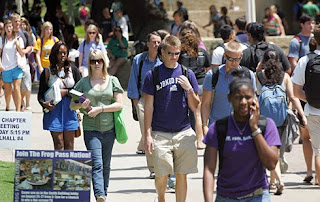
Almost three-quarters (73%) of American colleges and universities are reporting cases of influenza-like illnesses among students, with the highest rates in the Southeast and Midwest, the American College Health Association says.There were 4,045 new flu-like illness cases between Aug. 29 and Sept. 4 among 204 schools taking part in voluntary reporting, the new data show.
Most schools are not testing to confirm the virus is H1N1, or swine flu. But the Centers for Disease Control and Prevention says nearly all the flu virus now circulating is H1N1.
So far there has been only one flu-related college death. Troy University freshman Andrew Salter, 18, of Valley, Ala., died on Sept. 4 after fighting first H1N1 and then pneumonia, says university official Herbert Reeves.
Most schools are not testing to confirm the virus is H1N1, or swine flu. But the Centers for Disease Control and Prevention says nearly all the flu virus now circulating is H1N1.
So far there has been only one flu-related college death. Troy University freshman Andrew Salter, 18, of Valley, Ala., died on Sept. 4 after fighting first H1N1 and then pneumonia, says university official Herbert Reeves.
So far Washington State University in Pullman has been hardest hit, with about 2,500 cases, says the school's Paula Adams.
Schools that have sorority and fraternity rush preceding classes seem to be experiencing large numbers of cases, perhaps because those social settings allow the virus to be passed around, says James Turner, health association president.
At Mississippi State, with 423 cases, students came back the second week of August, and sorority "rush was the following week. That's when the cases started spiking," says spokeswoman Maridith Geuder. The University of Mississippi had 368 cases as of Tuesday at noon, says spokeswoman Barbara Lago. "We're hoping it's maybe run its course."
The good news is that the H1N1 flu appears to be fairly mild. While some people may have mild symptoms, others "may feel like a train has hit them" says CDC's Tom Skinner. Typical symptoms include fever, often over 101 or 102, headache, body aches, chills, sore throat and a cough.
The treatment is just to get students to rest in their rooms, drink plenty of fluids and not go out and infect anyone else.
0 comments